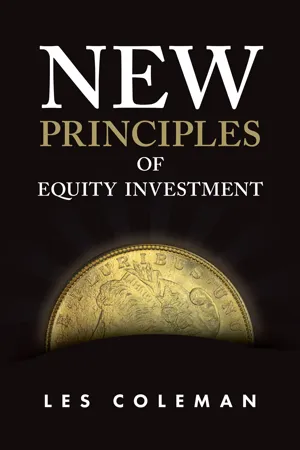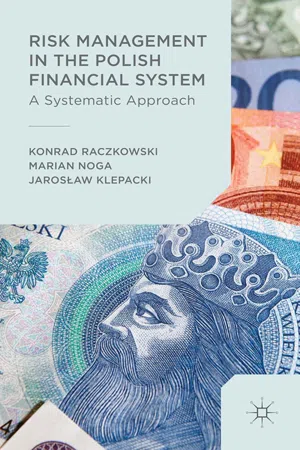Economics
Risk Asset
A risk asset refers to an investment that has a significant degree of price volatility and carries a higher risk of loss. These assets typically include stocks, commodities, and high-yield bonds. Investors are attracted to risk assets for their potential for higher returns, but they also come with a greater level of uncertainty and potential for financial loss.
Written by Perlego with AI-assistance
Related key terms
6 Key excerpts on "Risk Asset"
- Lukasz Snopek(Author)
- 2012(Publication Date)
- Wiley(Publisher)
Part II Asset Classes and Their Degree of RiskPassage contains an image Chapter 3 Asset Classes and Associated Risks At the start of our analysis, we indicated that investors seek to make a return in the form of income and/or capital gains.
To achieve this objective, they must be familiar with the investment universe available before making their investment choices.We define an asset class as a set of goods or securities (equity, debt or contracts) which exhibit the same characteristics, behave in the same way on the market and are governed by the same rules. Furthermore, an asset must be able to be traded on an organised market and generate an income and/or capital gains in the future. The main purpose of acquiring an asset is investment , i.e., to seek a return.This section begins with a review of the different asset classes and, more importantly, an analysis of the risks associated with each. Asset price fluctuations depend on whether or not different factors, or more precisely risks, materialise, and these risks are usually specific to each class. After identifying the risks, we will determine whether it is possible to hedge against them and, if so, how. The list of risks will be as comprehensive as possible.At the end of this section, we will classify the asset classes according to their degree of risk using several criteria. 3.1 Money Market Investments 3.1.1 DefinitionMoney market instruments include all short-term instruments with a maximum maturity of 12 months .These are highly liquid, high-quality debt investments that generate a modest yet regular income , such as government debt securities, certificates of deposit, commercial paper or fiduciary deposits.For private management, in terms of the form of investment, fiduciary investments are usually distinguished from money market funds. Although bonds with a maturity of less than one year belong to the money market category, they will not be considered in detail here as they are covered in the next section.1- eBook - ePub
Investment Valuation
Tools and Techniques for Determining the Value of Any Asset
- Aswath Damodaran(Author)
- 2012(Publication Date)
- Wiley(Publisher)
The final part of this chapter considers default risk and how it is measured by ratings agencies. By the end of the chapter, we should have a way of estimating the equity risk and default risk for any firm.WHAT IS RISK?Risk, for most of us, refers to the likelihood that in life’s games of chance we will receive an outcome that we will not like. For instance, the risk of driving a car too fast is getting a speeding ticket or, worse still, getting into an accident. Merriam-Webster’s Collegiate Dictionary , in fact, defines the verb to risk as “to expose to hazard or danger.” Thus risk is perceived almost entirely in negative terms.In finance, our definition of risk is both different and broader. Risk, as we see it, refers to the likelihood that we will receive a return on an investment that is different from the return we expect to make. Thus, risk includes not only the bad outcomes (returns that are lower than expected), but also good outcomes (returns that are higher than expected). In fact, we can refer to the former as downside risk and the latter as upside risk, but we consider both when measuring risk. In fact, the spirit of our definition of risk in finance is captured best by the Chinese symbols for risk:Loosely defined, the first symbol is the symbol for “danger,” while the second is the symbol for “opportunity,” making risk a mix of danger and opportunity. It illustrates very clearly the trade-off that every investor and business has to make—between the higher rewards that come with the opportunity and the higher risk that has to be borne as a consequence of the danger.Much of this chapter can be viewed as an attempt to come up with a model that best measures the danger in any investment, and then attempts to convert this into the opportunity that we would need to compensate for the danger. In finance terms, we term the danger to be “risk” and the opportunity to be “expected return.”What makes the measurement of risk and expected return so challenging is that it can vary depending on whose perspective we adopt. When analyzing the risk of a firm, for instance, we can measure it from the viewpoint of the firm’s managers. Alternatively, we can argue that the firm’s equity is owned by its stockholders, and that it is their perspective on risk that should matter. A firm’s stockholders, many of whom hold the stock as one investment in a larger portfolio, might perceive the risk in the firm very differently from the firm’s managers, who might have the bulk of their capital, human and financial, invested in the firm. - eBook - ePub
- Angelo Corelli(Author)
- 2019(Publication Date)
- Emerald Publishing Limited(Publisher)
Chapter 1
Risk: An Overview
Financial markets are typically characterized by transparent pricing and specific trading regulations. The costs, fees, and market forces determine the price of traded securities, and the risk embedded in any single trade.Risk can be defined as the possibility of negative outcome as a consequence of specific choices. In all fields of life, including business and financial activities, actions that lead to a loss can be defined as risk. Various types of risk daily affect a business; but when it comes to money, they can be mainly classified into two types: business risk and financial risk.Financial risk in particular involves the financial structure of the corporation. It generally arises by variability of prices and returns on financial markets. Movements can involve any kind of security as stocks, currencies, derivatives, and interest rates.Financial risk managers have the duty to perform identification, measurement, and hedging of risk, if necessary. Financial instruments can be used for the purpose but it is not always necessary to do that, since often risk entails the opportunity of a good expected return in exchange.It is not possible to prevent all possible risks, given some of them are unpredictable and not identifiable sufficiently in advance. However, for many types of risk, the analytical, computational, and numerical tools available in the literature can offer a way of reducing uncertainty. - eBook - ePub
- Richard E. Brown(Author)
- 2017(Publication Date)
- CRC Press(Publisher)
Section 5.2 . Investment return is defined as the expected value of this distribution divided by current price. Investment risk is defined as the standard deviation of this distribution. Definitions of investment risk and return are:Investment Return. The expected value of future investment price divided by current investment price.Investment Risk. The standard deviation of investment return, typically measured as a percentage of investment return (i.e., volatility).Portfolio theory builds on diversification theory; all of the mathematics and derivations assume a fully diversified portfolio with no idiosyncratic risk. All investments portfolios in the realm of portfolio theory are only exposed to systematic risk. Undiversified portfolios will not necessarily behave in the manner discussed in the remainder of this section.For clarity, the discussion on portfolio theory will assume that investments consist of companies that have publicly traded stock. Portfolios are created by buying and selling stock through the stock market. Portfolio theory can be easily extended to include any type of asset such as bonds, real estate, and commodities. Terms that are used synonymously in this section are investment, company, firm, security, and asset. Definitions of these investment types are provided to avoid confusion.Firm. A legally recognized business, corporation, partnership, or proprietorship.Company. A firm. The terms “company” and “firm” can typically be used interchangeably.Security. A negotiable contract representing financial value. Examples of securities include common stock, bonds, bank notes, and financial options.Asset. Something of value. A portfolio is comprised of individual assets such as securities.As has been previously discussed, investors prefer lower risk. This means that investments with more predictable returns have higher value than investments with less predictable returns. Consider two companies with publicly traded stock. The price of each stock is characterized by an expected return, p. The risk of each company is defined as the standard deviation of returns, o. Company A is a low risk and low return investment. Company B is a high risk and high return investment. - eBook - ePub
- Les Coleman(Author)
- 2019(Publication Date)
- Emerald Publishing Limited(Publisher)
4
Risk in Equity Investment
What distinguishes financial economics is the central role that uncertainty plays in both financial theory and its empirical implementation. Campbell, Lo, and MacKinlay (1997, p. 3)Change causes risk because lack of knowledge about its effects leaves open the possibility of unwanted outcomes. Obviously there is no risk in steady-state, predictable environments. However, equity prices – like other complex, human-based systems – are anything but steady-state and predictable: they involve high risk.As discussed in Chapter 1 , the decision to allocate funds to equities as an asset class is distinct from choice of individual equities. The latter task is the principal subject of this book, and involves taking on firm risks, which have two loci. The first is exogenous to the firm and is market related, especially the possibility of lower than expected return because selected stocks are misvalued; or arises during transactions because of counterparty and liquidity risks. The second locus of risk for equity investors is firm related and comes from lower than expected payoffs. This can be because of shortcomings in the firm’s operations and strategy, or agency problems. Other risks arise in firms’ environment, business and industry, including adverse changes in prices of products and inputs; and from third parties through credit default, contractual breaches and torts.As expressed in the quotation above, the distinguishing feature of investment is the need to balance the linked challenges of projecting return and possibility of loss, which requires investors to understand the nature and sources of firm risk. Because investment outcomes have a zero-sum, one party’s loss is the counterparty’s win and not everyone sees the same event as a risk.These perspectives point to the principal strategies for managing firm risk which are to either identify high-risk firms and avoid them or accept the risks in a firm and self-manage them. To support later discussion of investor management of risk, this chapter provides a framework for understanding how investors conceptualise risk, the nature of the relationship between risk and return and what determines investment risk. Consider each in turn. - eBook - ePub
- Marian Noga, Konrad Raczkowski, Jarosław Klepacki(Authors)
- 2015(Publication Date)
- Palgrave Macmillan(Publisher)
Market risk involved in investment activity should be defined as one of the most significant risks and the most difficult to manage as well. It may even be stated that this type of risk is resistant to portfolio or capital market position management. In other words, market risk involved in investments in the capital market may not be successfully limited, much less eliminated. This risk is identified with the nature of the specific area of investment, that is, the market in which capital is invested.The Bank for International Settlements has identified this type of risk as one of the five basic subcategories of financial risk. Market risk is defined as “the possibility of change to the financial circumstances as a result of change in market prices; it is placed next to credit, liquidity, operational, and legal risk” (Tymuł a, 2000, 16).This is a very general definition, however, it reflects the potentially very wide and varying scope of this risk well.An attempt at clarifying investment risk (which is continuous and fluctuating and not constant and isolated) for the purposes of the capital market has also been made by H. Markowitz, who classified market risk (otherwise known as systematic or nondiversifiable risk) as one of the two components (the other is specific risk) of the total risk. According to Markowitz, market risk is the result of the operation of external forces that are not subject to control of an entity running the risk (Ostrowska, 2002, 41–42). The sources of systematic risk are, for instance, changes in interest rates, inflation, tax regulations, or political and economic circumstances.The Polish Financial Supervision Authority (KNF), in contrast, characterized market risk after Krzysztof Jajuga (2007, 18–19) as the risk of the loss of assets, an increase in the level of liabilities, or a negative change in the financial results as a consequence of the volatility of market parameters (prices on the market) (Dajnowicz, 2011, 5). The KNF indicated the following components of this risk: currency risk, interest rate risk, commodity price risk, and instrument price risk. However, a structure of market risk concentrated, among others, on currency and interest rate risk is quite a broad generalization. Market risk is chiefly influenced by economic and/or political factors. The impact of one risk on another, referred to as the main and secondary risks (components), is definitely of an unclear character and mutual in this case. In other words, it is possible that at times market risk will exert greater influence over interest rate risk than interest rate risk on market risk within the structure of market risk (thus a question naturally arises: which one affects the other more profoundly?). This is also substantiated by the fact that, in principle, capital markets leverage certain events well in advance. It may thus be stated that currency risk, interest rate risk, commodity risk, and instrument price risk constitute a group of secondary risks related to the market risk. These are not, however, outright components of this risk as all the correlations within its structure are much more complex and multidimensional. The perfect example (in terms of directions and scale) of interaction among risks was the global financial crisis between 2008 and 2010. From a global perspective, one may observe that the impact of market risk on interest rate risk was greater than the other way round. Market risk had been shaping interest rate risk and not vice versa. From the point of view of the Polish economy, the sharp deterioration in the world economy, and first and foremost in the Euro Area, forced the Monetary Policy Council to carry out a series of reductions in the cost of money.
Learn about this page
Index pages curate the most relevant extracts from our library of academic textbooks. They’ve been created using an in-house natural language model (NLM), each adding context and meaning to key research topics.





